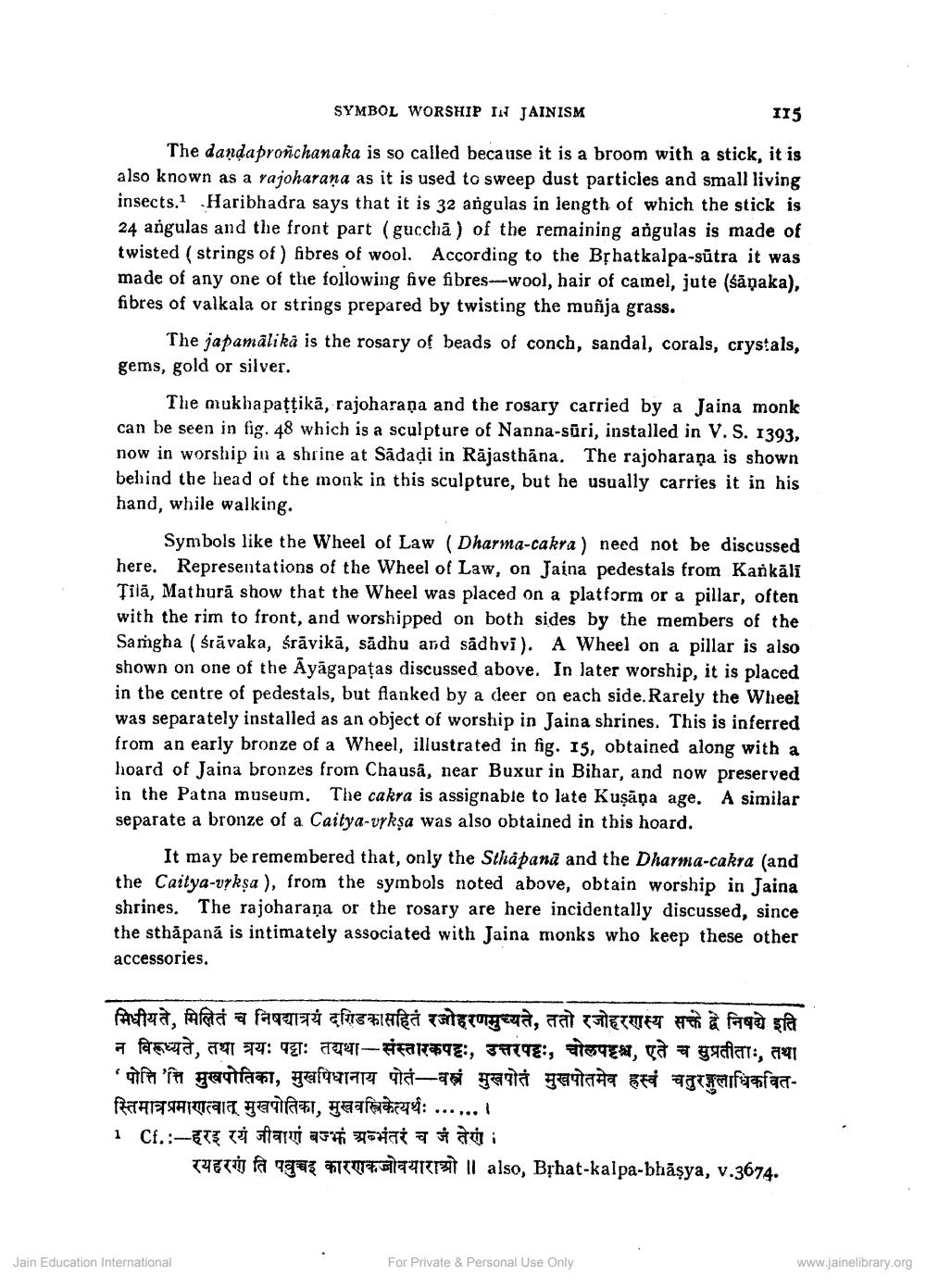________________
SYMBOL WORSHIP IN JAINISM
115
The dandaprońchanaka is so called because it is a broom with a stick, it is also known as a rajoharana as it is used to sweep dust particles and small living insects. Haribhadra says that it is 32 angulas in length of which the stick is 24 angulas and the front part (gucchā) of the remaining angulas is made of twisted ( strings of) fibres of wool. According to the Bșhatkalpa-sūtra it was made of any one of the following five fibres--wool, hair of camel, jute (šāņaka), fibres of valkala or strings prepared by twisting the muñja grass.
The japamālikā is the rosary of beads of conch, sandal, corals, crys!als, gems, gold or silver.
The mukha pațţikā, rajoharana and the rosary carried by a Jaina monk can be seen in fig. 48 which is a sculpture of Nanna-sūri, installed in V. S. 1393, now in worship in a shrine at Sādadi in Rajasthāna. The rajoharaṇa is shown behind the head of the monk in this sculpture, but he usually carries it in his hand, while walking.
Symbols like the Wheel of Law ( Dharma-cakra) need not be discussed here. Representations of the Wheel of Law, on Jaina pedestals from Kaňkāli
Tilā, Mathură show that the Wheel was placed on a platform or a pillar, often with the rim to front, and worshipped on both sides by the members of the Samgha ( śrävaka, śrāvikā, sādhu and sadhvi). A Wheel on a pillar is also shown on one of the Ayāgapatas discussed above. In later worship, it is placed in the centre of pedestals, but flanked by a deer on each side. Rarely the Wheel was separately installed as an object of worship in Jaina shrines. This is inferred from an early bronze of a Wheel, illustrated in fig. 15, obtained along with a hoard of Jaina bronzes from Chausā, near Buxur in Bihar, and now preserved in the Patna museum. The cakra is assignable to late Kuşāņa age. A similar separate a bronze of a Caitya-vykșa was also obtained in this hoard.
It may be remembered that, only the Sthapana and the Dharma-cakra (and the Caitya-vrkșa ), from the symbols noted above, obtain worship in Jaina shrines. The rajoharaṇa or the rosary are here incidentally discussed, since the sthāpanā is intimately associated with Jaina monks who keep these other accessories.
मिधीयते, मिलितं च निषद्यात्रयं दण्डिकासहितं रजोहरणमुच्यते, ततो रजोहरणस्य सक्ते द्वे निषधे इति न विरुध्यते, तथा त्रयः पट्टाः तद्यथा-संस्तारकपट्टः, उत्तरपट्टः, चोलपट्टश्च, एते च सुप्रतीताः, तथा 'पोत्ति 'क्ति मुखपोतिका, मुखपिधानाय पोतं-वस्त्रं मुखपोतं मुखपोतमेव ह्रस्वं चतुरङ्गुलाधिकवित
TAPETAIMAIT yatai, gaTraye: ......1 1 Cf.:- Ti sau amat Hari
TUETU fa 990 FTTTTT, OTATIT II also, Bțhat-kalpa-bhāşya, v.3674.
Jain Education International
For Private & Personal Use Only
www.jainelibrary.org




